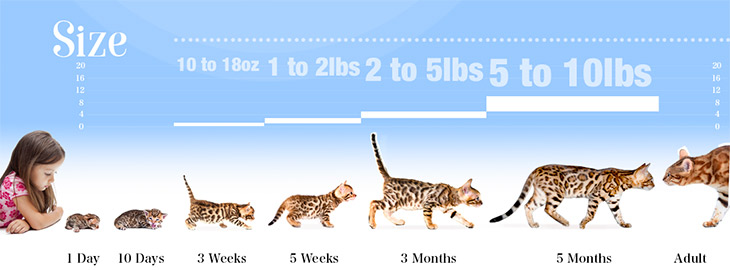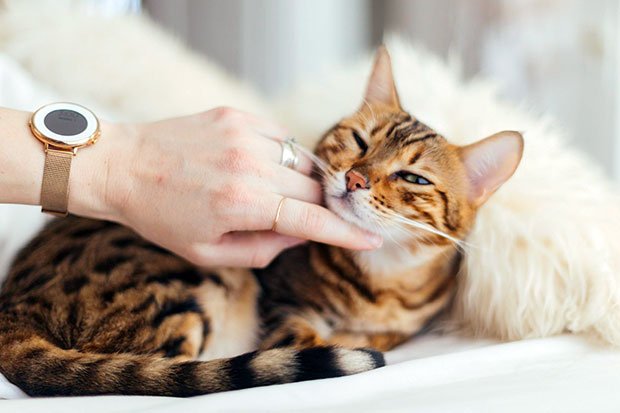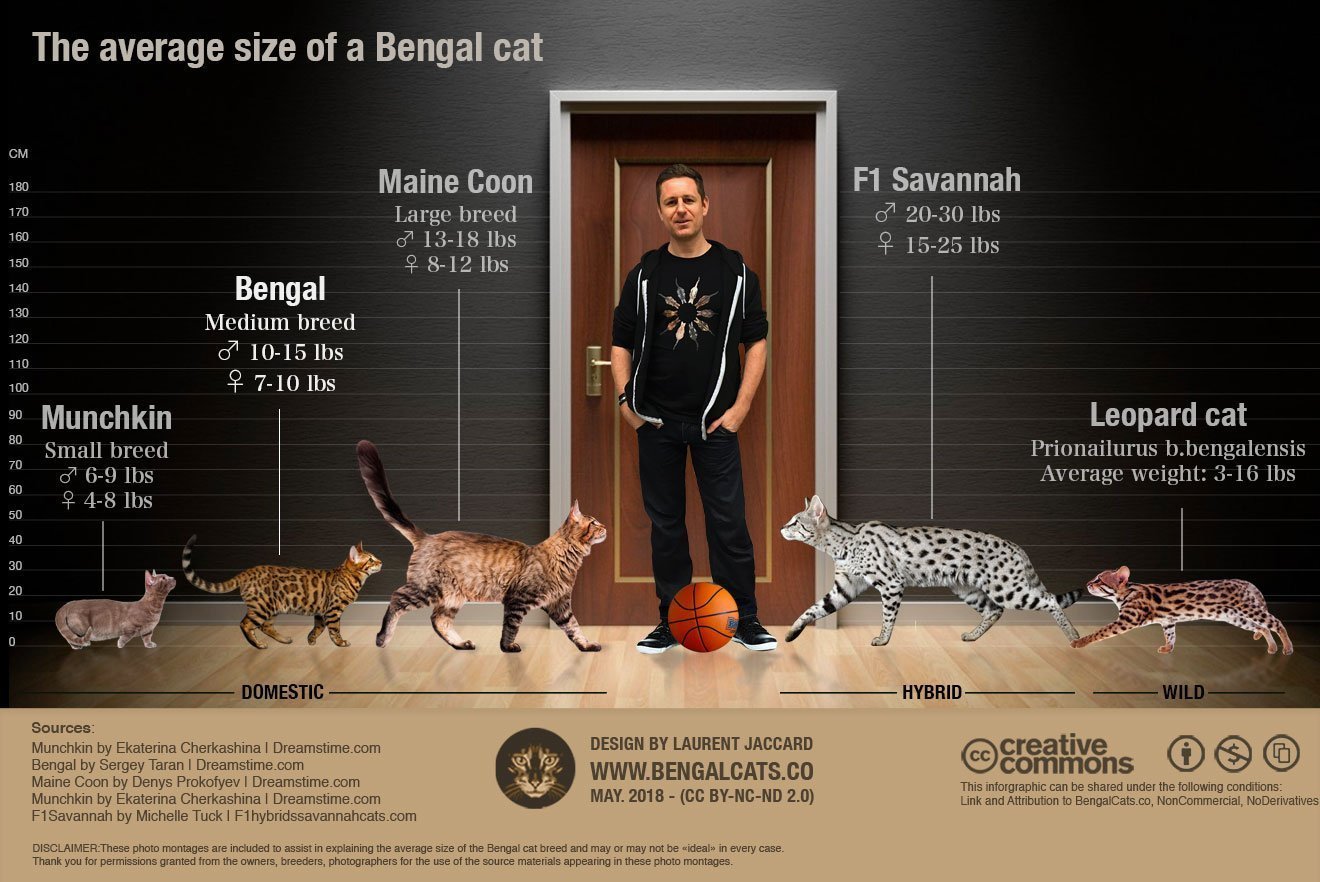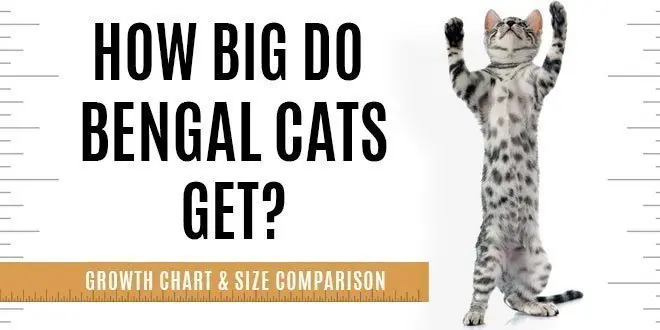Ultimately, nutrition plays a large part in your feline friend’s size and growth rate. But we’ll explain what to expect from the average full grown Bengal cat.
[dropcap]S[/dropcap]o, you are the proud new owner of a Bengal kitten! Chances are you probably have a lot of questions.
When will they become an adult? What is an ideal weight? What do full grown Bengal cats look like and act like?
If you have a kitten, you may wonder when your cat will reach its fully grown size. Is he done growing? Will he get even bigger?
These are the questions people keep asking about their cat’s growth, and we answer those in this article.
Look no further; we have the answers to all your Bengal cat size questions here.
When do Bengal kittens stop growing, and how big should they be?
Technically, Bengal kittens don’t stop growing, though they reach adulthood at anywhere from one-and-a-half to two years. A more precise answer is that Bengals stop being kittens at one year old. However, they are not quite adult Bengal cats yet, and are still growing.

In terms of current size, it all depends on the age. As you can see from the chart, any Bengal cat under two or three weeks old will weigh less than 10 ounces.
After 3 weeks, the average Bengal kitten will be 10-18 ounces.
Within the next two weeks this may double, making the cat 1-2 pounds on average. By the time the cat is three months old, its weight may have doubled again. And, two months after that, it may have doubled yet again.

By five months, it will be approaching the lower end of its adult weight at 5-10 pounds.
So when does a full grown Bengal cat stop growing, and how big do they get?
Honestly, it depends. In most cats, full size is reached at two years old, but some cats can continue to grow until age 3. Size can also vary, but typically, a full grown Bengal cat will fall in the range of 6-15 pounds.
This range accounts for both male and female cats, though size does vary by gender. Male cats tend to weigh anywhere from 10 to 15 pounds, while females grow to be about 7 to 10 pounds on average.
Even so, don’t be concerned if your cat falls slightly outside these limits. There’s a lot of variety in the breed, so outliers do happen.
Full grown Bengal cat size is complicated further by the genetic makeup of the breed. When Bengals were first bred in the 1980s, five different domestic cat breeds, and the wild Asian Leopard cat, were used in the process. These breeds included Abyssinians, Bombays, Ocicats, Egyptian Maus and British Shorthairs. The breeds range in size drastically, with some averaging at 10 pounds and the largest averaging at 15.
Size may also depend on how distant your Bengal cat is from the Asian Leopard cat. Very distant cats tend to be medium sized on average.
In fact, the breed was meant to be a toy version of a large breed. This may be why larger Bengal cats are generally less popular.
One side-effect of this process was that genetic makeup tended to affect the cats’ sizes. So, if you have an especially small Bengal cat, that may just mean that it has a lot of Abyssinian or Bengal (both averaging ten pounds) in its bloodline, whereas an exceptionally large cat may have more British Shorthair (average of 15 pounds) in its makeup.
Bengal cat size vs other cats

Bengal cat size and weight compared to a 5’10 (180 cm) human. This photo montage also illustrates how big a Bengal cat is compared to a Maine Coon (large breed), a Munchkin (small breed), an F1 Savannah (hybrid) and a Leopard cat.
How to Tell if Your Cat is Too Fat or Thin
First off, don’t jump to conclusions. A full grown Bengal cat is very muscular, and as a result, most tend to look and feel heavier than they are. As with dogs, one way to determine whether your cat is in a healthy weight range is to weigh it.
You can determine a cat’s weight pretty simply.
First, just weigh yourself to get a base weight. Then, pick up your cat and weigh yourself. Subtract the first weight from the second, and you’ll get your cat’s weight.
Keep in mind, weight is not an end-all be-all. In addition to being out of weight range and being healthy, your cat could also be within its weight range, but still be unhealthy.
Usually just looking at your cat cannot tell you whether or not they are at an unhealthy weight. Instead, it’s best to get a professional opinion. Take your cat to the vet and let them examine the cat.
How Do I Put a Full Grown Bengal Cat on a Diet?
If your full grown Bengal cat does turn out to be too fat or thin, there are a few potential reasons why.
It could be because your cat is overfed or underfed.
It can be very easy to overfeed a cat. A study conducted in 2014 found that over 50% of house cats were overweight.
One possible solution to this is to put your cat on a diet.
Do you feed your cat whenever they’re hungry? If you do, don’t feel bad. It’s our first instinct to feed an animal whenever they start begging
The problem with this is that, for a full grown Bengal cat, their appetite might outpace their metabolism. If this seems to be the case with your cat, try feeding your cat only once per day and see if they lose any weight.
One definite piece of advice is to stay away from automatic feeders. Though it may save work for you, it doesn’t do the cat any good.
Your cat may also need more exercise. Also, try to give them a toy, or take them out more. A full grown Bengal cat will want to play, so this part shouldn’t be too hard.
In general, Bengals are so energetic that they burn off a lot more calories than other domestic breeds.
Is There an Ideal Diet for a Full Grown Bengal Cat?
Actually, yes, there is. Try putting your cat on a raw food diet. Simply put, a raw food diet is one which mimics a cat’s natural diet as closely as possible.
This involves feeding the cat only meat, specifically meat it might hunt in the wild. Just don’t feed it anything that eats meat, so no carnivores, and no omnivores.
Also, part of the cat’s diet will have to consist of bones. If you’re not sure which bones your cat can ingest, feed it raw sardines. They’re fairly easy to find and your cat can digest them.
One thing we must emphasize about the raw diet is that it is raw. Do not cook anything.
Also, don’t feed the cat dry food or any fruits or vegetables.
All in all, this form of diet is a lot healthier for your cat than a standard pet food diet. It can clean the cat’s teeth, strengthen its immune system, keeps the cat hydrated, and gives it a healthier and shinier coat of fur.
A full grown Bengal cat, and really any cat, for that matter, is a natural hunter and should be treated like one.
What if Your Cat is Too Thin?
But, what do you do if your cat is underweight? This can result from a lot of factors, so it’s not necessarily your fault. Even if you did underfeed your cat, at least you caught it in time, and now you can correct it.
Sometimes, it can be just bad luck. If your cat was unfortunate enough to get sick at a young age, it could have caused them to stop eating or eat little for a while, stunting their growth.
The good news is that there are ways to encourage your cat to eat more, such as heating up his food slightly, adding water to his food, or even just switching to soft food. As an added benefit, switching to softer food can help if you have a cat suffering from constipation.
Cats, like humans, tend to develop digestive issues when they get older, so eventually, hard food stops being a good idea. You can tell if a cat is getting older if you start to see black spots on their lips. This is the feline equivalent of liver spots.
This may seem obvious, but take your cat to the vet anyway, just to make sure there isn’t a current medical problem that’s causing them to lose weight. Weight loss can be a symptom of a lot of issues, one of the more serious of which is worms.
What About Other Features? What Makes Bengal Cats So Distinct?
The features of a full grown Bengal cat are some of the most interesting things about it.
One of the reasons Bengal cats were originally bred had to do with the distinct markings on certain species of wildcats. The first Bengal cats were bred in the 1970s as part of a cancer research program at Loma Linda University.
When the project ended, the research leader, Dr. Centerwall, had to adopt out the experimebetntal kittens. During this process, he met Jean Sugden Mill, who quickly fell in love with the cats and set out to breed more of them.
What attracted Mill, and others, to the Bengal breed was the markings on their fur, which reminded her of some kind of domestic jungle cat.
On that note, Bengal fur is not one size fits all. Bengals come in several different colors and two different patterns: marbled and spotted.
Indeed, the Bengal cat is unique in many ways, and the markings are just one of them.
For instance, a Bengal’s head is quite unique compared to other cats. The head itself is disproportionately small, as are the ears. The eyes, however, are often large, and range in color from green, to yellow, to blue.
Some of the most intriguing and beneficial aspects of Bengal cats are that Bengal cats are hypoallergenic and do not shed. Additionally, a full grown Bengal cat is one of the smartest cats out there, making it a triple threat when it comes to what cat should you get.
Your Bengal Friend and You
Bengal cats are very beautiful animals, known for their coat, their size, and their big brains. Originally bred from a mixture of an Asian Leopard cat and five breeds of domestic cat, the Bengal has quickly become a favorite among humans, and has adapted quite well to the role.
Bengals mature at about the same rate as most other cats, or dogs. It stops being considered a kitten after a year but does not become a full grown Bengal cat until usually a year-and-a-half or two years.
Even after two years, they can keep growing, sometimes into their third year.
Overall, Bengal cats can get very big, weighing up to fifteen pounds of mostly muscle, but they don’t always. Depending of the sex of the animal, and particular genetic makeup, a full grown Bengal cat can range anywhere between seven pounds to fifteen pounds, and some even fall outside that range and are still considered healthy.
If your cat is underweight or overweight, don’t worry, because there are a lot of ways to solve this. An overweight cat can always be put on a diet. They won’t like it, but it will work. For underweight cats, you can always moisten or heat up their food, or just switch to moist food if you haven’t already.
Bengal cats also have many noteworthy facial features. Pay attention for the small head and ears, the big eyes, and the distinctive M on their foreheads. It should be noted that this “M” isn’t just seen on Bengals but on tabbies of all breeds.
For more information about Bengal cats, feel free to visit our articles page. We can also help you find other Bengal cat enthusiasts or good breeders to adopt from.




